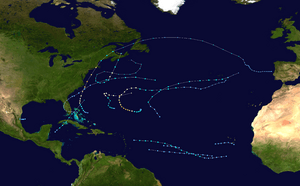1991 Atlantic hurricane season facts for kids
 |
|
| Season summary map | |
| First storm formed | July 2, 1991 |
|---|---|
| Last storm dissipated | November 2, 1991 |
| Strongest storm | Claudette – 944 mbar (hPa) (27.89 inHg), 130 mph (215 km/h) |
| Total depressions | 11 |
| Total storms | 8 |
| Hurricanes | 4 |
| Major hurricanes (Cat. 3+) | 2 |
| Total fatalities | 30 |
| Total damage | ~ $1.7 billion (1991 USD) |
| Atlantic hurricane seasons 1989, 1990, 1991, 1992, 1993 |
|
The 1991 Atlantic hurricane season was a time when tropical storms and hurricanes formed in the Atlantic Ocean. It officially began on June 1, 1991, and ended on November 30, 1991. However, storms can sometimes form outside these dates. This season had less activity than usual. There were only 4 tropical depressions, 4 tropical storms, 2 hurricanes, and 2 major hurricanes.
Contents
Understanding Storms in 1991
During the 1991 season, different types of storms developed. These included tropical depressions, tropical storms, and hurricanes. Each type has different wind speeds and power.
Tropical Depressions
A tropical depression is the weakest type of tropical cyclone. It has organized thunderstorms and a clear center of circulation. Its winds are 38 miles per hour (61 km/h) or less. In 1991, there were four tropical depressions that did not grow stronger.
Tropical Storms
When a tropical depression's winds reach 39 mph (63 km/h), it becomes a tropical storm. At this point, it is given a name. The 1991 season had four named tropical storms: Ana, Danny, Erika, and Fabian.
Hurricanes and Major Hurricanes
A tropical storm becomes a hurricane when its winds reach 74 mph (119 km/h). Hurricanes are very powerful storms. If a hurricane's winds reach 111 mph (178 km/h), it is called a major hurricane. The 1991 season had two hurricanes: Bob and Claudette. Both of these became major hurricanes.
Hurricane Bob's Impact
Hurricane Bob was a strong storm that hit the East Coast of the United States. It caused a lot of damage, especially in New England. Bob was a Category 2 hurricane when it made landfall. It brought heavy rain and strong winds.
Hurricane Claudette's Strength
Hurricane Claudette was the strongest storm of the 1991 season. It reached Category 4 strength. This means its winds were very high. However, Claudette stayed over the open ocean. It did not make landfall and caused no damage to land.
The "Halloween Nor'easter"
One unusual storm was Hurricane Eight, also known as the 1991 Halloween Nor'easter. This storm was unique because it was not a typical tropical hurricane. It formed from a mix of weather systems. It caused huge waves and coastal flooding. This storm affected the East Coast of the United States.
Hurricane Name Retirement
Sometimes, a hurricane name is "retired." This means the name will not be used again for future storms. This happens when a storm causes a lot of damage or deaths. The name is retired to honor the victims and prevent confusion.
Why Bob's Name Was Retired
In the spring of 1992, the name Hurricane Bob was retired. This was because Hurricane Bob caused significant damage. It was replaced by the name Bill for the 1997 season.
See also
 In Spanish: Temporada de huracanes en el Atlántico de 1991 para niños
In Spanish: Temporada de huracanes en el Atlántico de 1991 para niños

